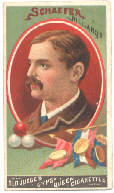Balkline
The top players of straight rail became so skillful that they would score a seemingly endless series of points, with the balls barely moving in a confined area of the table.
[7] Skill in the professional game increased mostly through the refinement of gather shots and the development of a variety of "nurse" techniques.
[1][9] At the U.S. straight rail professional tournament held in 1879, Jacob Schaefer Sr. scored 690 points in a single inning at the table.
[10] Shortly after, with the specific intent of frustrating nurse shots along the rail,[1] officials employed diagonal lines at the table's corners to regions where counts were restricted, an expansion of the crotching rule that came to be known as the "champion's game".
"[13][14] Ultimately, despite its divergence from straight rail, the champion's game simply expanded the dimensions of the balk space defined under the existing crotch prohibition which was not sufficient to stop nursing.
However, because high runs once again increased as skill compensated for the new conditions, in 1883 the balklines were accepted, replacing the champion's game in tournament play.
[1] On 1894, Chicago billiard hall owner J. E. Parker, after Schaefer and Frank C. Ives both posted extensive runs at his hall using the anchor nurse, suggested adding a rectangular marking straddling the spot where the balkline meets each rail, known as the anchor space and nicknamed the "Parker's box".
[1] True to form, the next skill development response was the chuck nurse, known as a rocking cannon in the United Kingdom.
[1] By contrast, in 71.2 balkline, of French origin, lines are drawn 71 centimetres (28 in) from each rail, also with a two count restriction for balk spaces.




